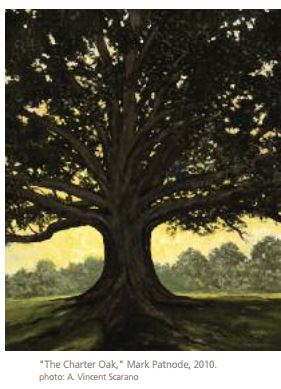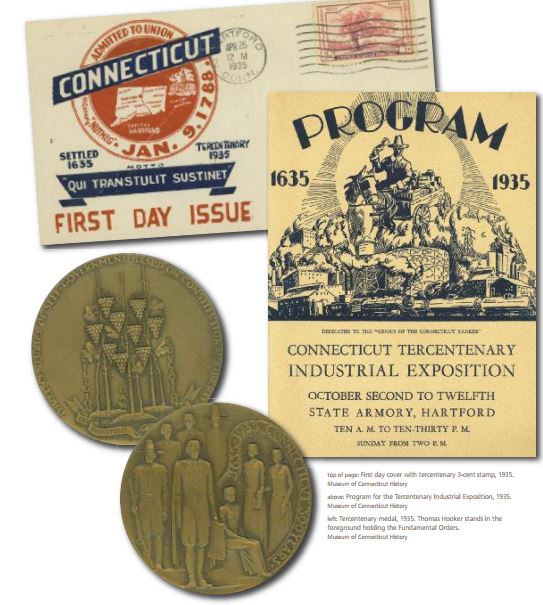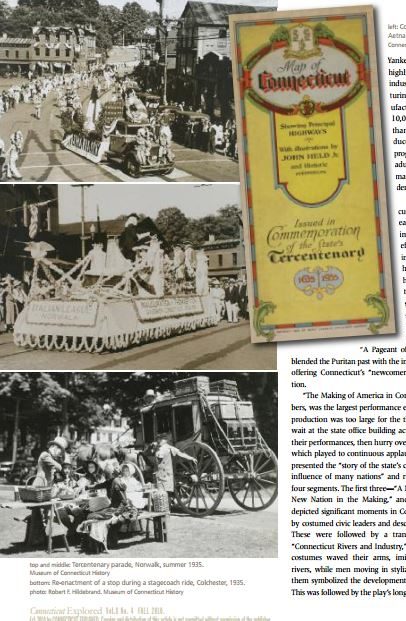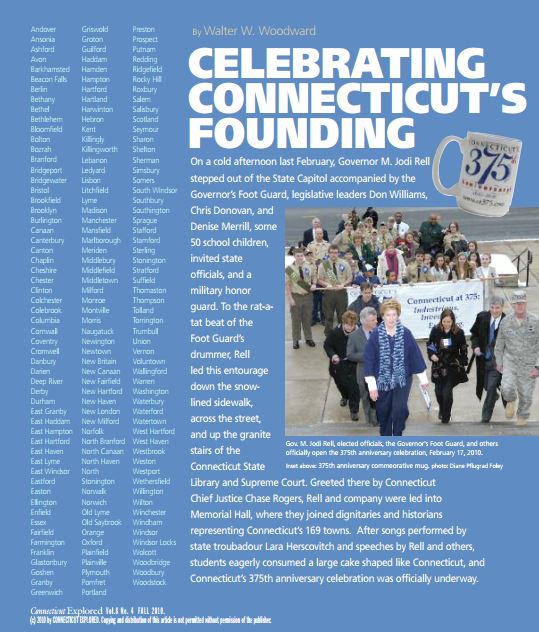By Walter W. Woodward
(c) Connecticut Explored Inc. Fall 2010 Vol 8 # 4
Subscribe/Buy the Issue!
On a cold afternoon last February, Governor M. Jodi Rell stepped out of the State Capitol accompanied by the Governor’s Foot Guard, legislative leaders Don Williams, Chris Donovan, and Denise Merrill, some 50 school children, invited state officials, and a military honor guard. To the rat-atat beat of the Foot Guard’s drummer, Rell led this entourage down the snow lined sidewalk, across the street, and up the granite stairs of the Connecticut State Library and Supreme Court. Greeted there by Connecticut Chief Justice Chase Rogers, Rell and company were led into Memorial Hall, where they joined dignitaries and historians representing Connecticut’s 169 towns. After songs performed by state troubadour Lara Herscovitch and speeches by Rell and others, students eagerly consumed a large cake shaped like Connecticut, and Connecticut’s 375th anniversary celebration was officially underway.
Pulled together swiftly by a group of volunteers, the year-long commemoration of Connecticut’s 375th birthday has been—perhaps as it should be in a time of economic challenge—a relatively circumscribed affair. The commemorative activities, built around the theme “Connecticut. Industrious. Inventive. Enduring” (the brainchild of state librarian Kendall Wiggins) has included the creation of a painting of the Charter Oak by landscape artist Mark Patnode, a student art contest featuring Connecticut landmarks, a governor’s summer reading program featuring Connecticut authors, admission-free weekends at Connecticut’s state parks and forests and at many Connecticut museums and historic sites, and a reprise of documentaries about Connecticut history on CPTV. A special 375th anniversary stamp was placed in 28 of the state forests’ letter boxing locations. (See Explore! below for more information.) Many local historical sites, service organizations, and schools have also coordinated programming with the 375th celebration. The last and perhaps most enduring of these events will be a new exhibit about the state’s history opening in December at the Connecticut Historical Society.
Funded completely by private donations, the 375th is more limited than previous commemorations, but the enthusiastic response it has generated shows Connecticans’ continuing appreciation for state history. Still, the diffuse nature of these celebratory events suggests that the public’s actual knowledge about Connecticut’s history and appreciation of its importance as a guide to our future may also be weakening. This is not a new concern, but the continuation of an old one, one that received voice—and plenty of it—25 years ago, when Connecticut celebrated its 350th birthday.
Connecticut’s 350th Anniversary
Connecticut’s 350th anniversary, celebrated from May 1, 1985 to April 25, 1986, began with a pre-event that was, at best, politically inexpedient. In late January 1985, three months before Governor William J. O’Neill officially declared the start of the state’s 350th anniversary, he, along with state politicos, held what amounted to a de facto private kickoff at the State Library. A select guest list of about 300 officials, including 7 living governors, members of the General Assembly, persons of influence, and members of the media, was invited to a gathering featuring a Connecticut cake, hors d’oeuvres, wine, the First Company and the Governor’s Foot Guard, the 175-member East Lyme High School Viking Band, and a lavish fireworks display over the State Capitol. Members of the public, unaware of the event, reacted to the sudden explosions by calling in a number of alarms, which in turn produced a brief, but sharp, reaction from some newspaper columnists, who bristled at the public’s exclusion from the event.
Despite this false pre-start, the 350th celebration was launched again on May 1 with O’Neill’s formal proclamation. At noon, officials in Connecticut’s 169 towns released more than 50,000 balloons—350 per town. Special 350th anniversary flags flew, bells rang, and cannons were fired. During the ensuing year, commemorations of all shapes and sizes took place. Vernon, for example, celebrated by holding a cow-chip (dried cattle dung) tossing contest. Beard-growing contests were held in Bristol, East Haven, and Bloomfield. Middlebury held an event showcasing Connecticut wines. Connecticut Celebration 350th, established by the State Department of Economic Development (DEC) to plan the commemorative events, awarded plaques to the oldest house in each town. The exhibition “The Great River: Art and Society of the Connecticut Valley, 1635-1920” enjoyed a four-month run at the Wadsworth Atheneum.
The penultimate event was a gala parade in New Haven, held April 19, 1986, that involved approximately 17,000 marchers and featured a 500-piece birthday cake, “The World’s Biggest Milkshake,” marchers from 130 Connecticut towns, and an array of clowns and mimes. Concluding the nearly year-long celebration was “History Day at the Old State House,” an 18th-century military encampment held 350 years to the day after the first meeting of Connecticut’s General Court. Governor O’Neill, standing among actors dressed as famous historic Connecticans—from Noah Webster to Prudence Crandall—officiated at the lowering of the 350th Anniversary commemorative flag to the accompaniment of several gunpowder salutes.
Reaction to Connecticut’s 350th celebration was decidedly mixed. While DEC chairman Peter Burns expressed pride that more than a million people had participated in one or more of the state’s events, historians were not nearly so cheerful. Then state historian Christopher Collier lamented the celebrations’ circus-like atmosphere. “The people who ran it had no sense of history whatsoever,” Collier said. “They missed a great opportunity to interest people in Connecticut’s history and to inform them. These people don’t even know what they’re celebrating.” Ellsworth Grant, president of the Connecticut Historical Society, seconded Collier’s critique. “From a historical standpoint,” he said, “the celebration was totally inadequate. I like to recall the quotation of Carl Sandburg that whenever society or a nation perishes, one condition can always be found: They forgot where they came from.”
When is Connecticut’s Birthday?
One of Collier’s criticisms of the 350th commemoration was that O’Neill chose an arbitrary and historically questionable year to celebrate the state’s birthday. Collier’s argument had substance, but O’Neill’s choice also had good grounds.
The question of when to celebrate Connecticut’s birth is a tricky one, first raised in 1928, when state historical organizations met to begin planning what was most certainly the greatest commemorative event in the state’s history, our 300th anniversary. There were many options to choose from, but no clear standout. Windsor was first settled in 1633, Wethersfield in 1634. The Fundamental Orders creating Connecticut’s governmental institutions were passed in 1639. Other dates also presented themselves.“ The question is a curiously complicated one,” noted Yale professor Charles M . Andrews.“ The dates of Connecticut’s founding run through at least six years, from 1633 through to 1639, and just which point in that period of six years is to become the object of our veneration has not yet become known.”
The question wasn’t decided officially until 1934, when Tercentenary Commission member George Matthew Dutcher announced that 1935 had been selected for the celebration because in 1635 “the beginning of settlement had been made” at the three original Connecticut River towns and a fort had been established at Saybrook. He noted that although civil government for Connecticut wasn’t created until 1636, a 1936 Connecticut celebration would conflict with Rhode Island’s tercentenary events. Therefore 1935 would mark Connecticut’s 300th. This set a precedent. Governor O’Neill, following the lead of the Tercentenary Commission, chose 1985 as the date of our state’s 350th, and Governor Rell chose 2010 as the 375th.
Connecticut’s 300th Anniversary
There was no official celebration of the state’s 325th—it fell during the election year 1960—possibly because the magnitude of the 300th still rang in people’s memories. Despite the Great Depression, Connecticut’s six-month tercentenary celebration caught the imagination of an entire citizenry. At its conclusion, Th Hartford Courant editors wrote, “ It would be hard to find anyone in this state, free, sane, well and over five, who has not participated in the festivities.” Coming at the end of an era of great historical pageantry, in the midst of the colonial revival period,and at a time when the eugenics movement had increased people’s interest in their historical and genealogical roots, Connecticut’s tercentenary channeled all these strands of contemporary culture in to a great out-pouring of historical celebration. Seven years in the planning, and funded by the General Assembly to the tune of $125,000, the tercentenary generated hundreds of local events across the state, significant cultural and educational programs, and several star productions that may remain unique in our history.
While Windsor and Wethersfield had whetted the state’s appetite for commemoration with major local tercentenary celebrations in 1933 and 1934, the statewide celebration of Connecticut’s founding was officially bracketed between two historically significant dates in 1935: April 26, the 199th anniversary of the first meeting of the General Court, and October 12, Columbus Day.
Governor Wilbur Cross’s opening of the celebration set the precedent for future commemorative inaugurals in form but on a much grander scale than they would achieve. At noon on the 26th, while bells throughout the state pealed and car horns honked, Cross, accompanied by the Foot Guard, the lieutenant governor, the Supreme Court justices, members of the General Assembly, the governor’s staff,and the color bearers and band of Putnam’s Phalanx marched smartly from the Capitol to the Bushnell auditorium, where 3,300 representatives of fraternal, civic, military, and historical societies and the general public waited to greet them. All sang “America” and, after a poetic invocation, greetings were received from the governors of Vermont and New Hampshire, a keynote address reviewing the state’s constitutional history was given by Chief Justice William Maltbie, and the self-deprecating Governor Cross officially opened the tercentenary celebration. He praised the state’s history, while noting his own less-than-perfect ties to Connecticut’s Puritan past: One Cross ancestor was fined for selling wine without a license, while another obtained Connecticut’s first divorce, from a wife “who preferred to live in England.”
 In a pattern reflected throughout the tercentenary period, the official kick off was only one of many commemorative events held on April 26. Earlier, the governor had received the first official tercentenary postage, a three-cent stamp engraved with an image of the Charter Oak. At the same time, officials at Aetna Casualty unveiled a commemorative map showing all the state’s highways and featuring historical sites. At the White House, First Lady Eleanor Roosevelt attended the planting of a scion of Connecticut’s Charter Oak on the White House lawn by two Connecticut Girl Scouts, and in Simsbury, the tercentenary celebration announced the forthcoming publication of a short history of Simsbury.
In a pattern reflected throughout the tercentenary period, the official kick off was only one of many commemorative events held on April 26. Earlier, the governor had received the first official tercentenary postage, a three-cent stamp engraved with an image of the Charter Oak. At the same time, officials at Aetna Casualty unveiled a commemorative map showing all the state’s highways and featuring historical sites. At the White House, First Lady Eleanor Roosevelt attended the planting of a scion of Connecticut’s Charter Oak on the White House lawn by two Connecticut Girl Scouts, and in Simsbury, the tercentenary celebration announced the forthcoming publication of a short history of Simsbury.
For the next six months, Connecticut was abuzz with events celebrating its Puritan and industrial history. Almost every town sponsored some kind of ceremony. Historical societies hosted exhibits, and patriotic organizations published pamphlets. Monuments were unveiled and plaques installed. The state was a wash in historical reflection.
Highlights among the hundreds of tercentenary activities included a June 1 choral concert of more than 3,000 singers from 73 state glee clubs (accompanied by a 100-piece orchestra) before an audience of more than 15,000 at the Yale Bowl. In September, more than 400,000 Connecticut school children participated in Connecticut Education Day, which focused their attention on the study of Connecticut history. The tercentenary commission issued a series of short monographs on colonial Connecticut history; these are still considered vital references. The Hartford Times published in hardback a three-volume comic-book-style history of Connecticut.
Three early-October events brought the half-year of festivities to a climax. The first was the Tercentenary Industrial Exhibition, held at the state armory in Hartford. Dedicated“ to the genius of the Connecticut Yankee,” the 31 groups of exhibits highlighted the state’s history of industrial invention and manufacturing leadership. Connecticut manufacturers displayed more than 10,000 product lines with more than 700,000 Connecticut-produced items. The “pageant of progress” drew more than 200,000 adult visitors and attracted as many as 75,000 Connecticut students.
The second of the final weeks’ culminating events combined early history with recognition of immigration’s transformative effect. “The Making of America in Connecticut,” a three-and-ahalf-hour pageant incorporating historical reenactment, tableaux, dance numbers, and singing, played on the Bushnell stage for three nights to packed houses of more than 3,000 viewers each night. Subtitled “A Pageant of the Races,” the extravaganza blended the Puritan past with the immigration-transformed future, offering Connecticut’s “newcomers” inclusion through assimilation.
“The Making of America in Connecticut,” with 600 cast members, was the largest performance ever staged at the Bushnell. The production was too large for the theater’s facilities; actors had to wait at the state office building across the street until just before their performances, then hurry over to the theater. The pageant— which played to continuous applause from delighted audiences— presented the “story of the state’s cultural development under the influence of many nations” and recounted the state’s history in four segments. The first three—“A New Colony in the Making,” “A New Nation in the Making,” and “The Union is Preserved”— depicted significant moments in Connecticut history acted largely by costumed civic leaders and descendants of early Connecticans. These were followed by a transitional dance number titled “Connecticut Rivers and Industry,” in which 100 women in blue costumes waved their arms, imitating Connecticut’s powerful rivers, while men moving in stylized mechanical fashion among them symbolized the development of industry along those rivers. This was followed by the play’s longest section, “A New State in the Making,” intended to show “all the foreign influences that have been blended into ours.” The eight numerically largest groups of industrialrevolution immigrants to Connecticut—French Canadian, Czechoslovakian, Italian, Lithuanian, German, Swedish, Polish, and Russian—each presented a performance showing ways in which their culture had enriched Connecticut. The Germans offered a 150-voice Saengerbund Chorus, while the Italians had 50 young women performing “O Sole Mio.” Czechs performed folk dances, and the Polish contingent recreated Thaddeus Kosciusko presenting credentials to George Washington.
The play’s finale featured 19 families of four representing each of the “races” in Connecticut (including the original Puritan stock) marching from the back of the theater to the stage to sign the “Pact of Connecticut,” a document promising the state a glowing future based on unity, good will, and understanding. While Albanians, Armenians, Danes, French, Hungarians, Irish, Norwegian, Portuguese, Russian, Scottish, Swedish, and Ukrainian families were invited to join the eight largest “races,” neither Indians nor African Americans were included. Indians and African Americans were not completely left out of the tercentenary celebration, however. The Mohegan Tribe celebrated during its August wigwam festival, and African Americans held a wellattended musical performance in honor of the tercentenary at Hartford’s State Theater. Still, Connecticut’s “Pageant of the Races” excluded both groups.
The culminating activity was the largest parade the state had ever seen. Twenty thousand marchers, more than 100 floats and 30 bands, and nearly 500 schoolchildren passed before a reviewing stand of dignitaries and celebrities from a dozen states, including the heavyweight boxing champion Gene Tunney. The patriotically themed parade focusing on Connecticut history lasted nearly three hours. More than 400,000 people—almost a third of the state’s population—watched, and in downtown Hartford phone books became scarce as observers in office buildings shredded the books into confetti to shower on marchers. The themes of the top three prize-winning floats—first place went to “The First Thanksgiving Dinner;” second place to “The Viking Ship;” and third place to “The Pioneer”—underscored the celebration’s historical focus. One columnist noted it was “a parade worth waiting 300 years for.”
A costume ball was held in New Haven later that night, and with the observance of “Connecticut Sabbath” the next morning (in which many churches conducted services using historical liturgies), the tercentenary celebration officially ended. In the afterglow of the celebration, Tercentenary Commission Chair Colonel Samuel Herbert Fisher received encomiums both for the scale of the events and his genius for local initiative. The Hartford Courant noted that the tercentenary had increased tourism, produced remarkable memorials, and stimulated important research. But the greatest benefit The Courant found was that “knowledge and respect for the founders and builders of Connecticut have been deepened,” and respect for the “culture, skills and qualities… brought into Connecticut by the successive waves of migrations of immigrants” had greatly increased. This in turn had produced a “determination to work together for the future prosperity and progress of the state.”
Even as we enjoy the enriching events of this year’s 375th anniversary, Connecticans might do well to think of the even greater anniversary 25 years from now and resolve to make it as encompassing and memorable as Connecticut’s 300th.

